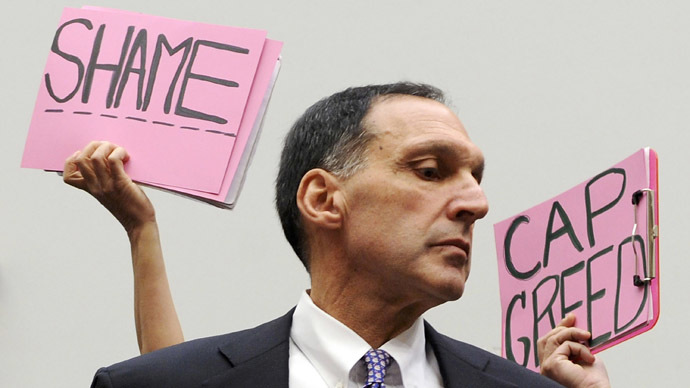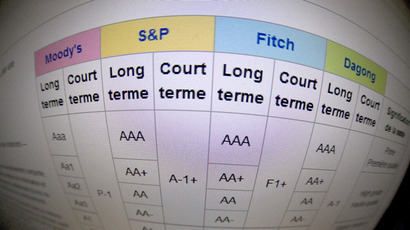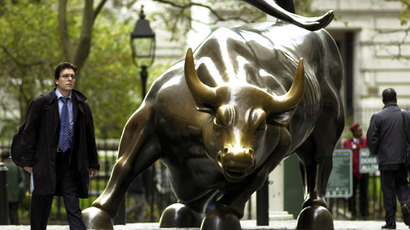The biggest fall: Lehman Brothers, 5 years on

The US is just emerging from the financial meltdown and experts are asking if it will happen again. Wall Street is “reformed” with new “anti-crisis tools,” while Lehman Brothers’ former CEO is tucked away in his $19 million Sun Valley, Idaho mansion.
On September 14, 2008, Lehman was the fourth-largest investment
bank in the US. On September 15, in the early hours of the
morning, the firm filed for bankruptcy.
Lehman went bust in a sensational downfall, as its stocks became
valueless and the firm was downgraded by rating agencies. After a failed acquisition by
Barclays and minutes before Japanese markets opened, Lehman
declared bankruptcy, which eventually pulled the entire global
economy into a tailspin.
The day before Lehman announced bankruptcy, America’s secretary
treasurer Hank Paulsen flew from DC to New York for an emergency
meeting with Wall Street's top bankers. Paulsen refused to bail
out Lehman, proving to America some banks weren't "too big to
fail."
The Dow and the Nasdaq crashed, hitting lows that weren’t seen since
the financial crisis of 1987, and two days later, the US
government bailed out AIG, an insurer which had backed billions
in subprime loans.
The US government shelled out dough to save GE and Chrysler,
companies as American as apple pie, and employed hundreds of
thousands of people who weren’t Wall Street bankers, but plant
workers and manufacturers.
Four months later, and three days before Obama’s inauguration as president, Bank of America received $20 billion from the Trouble Asset Relief Program (TARP). If the government hadn’t intervened, many other top banks would have shared Lehman’s fate.The Fed put together a giant, $800 billion bailout for Wall Street at US taxpayers’ expense.
The US government became a lender of last resort, and the UK
government also handed out massive bailouts to subsidize British
banks.
The source of the 2008 crisis is still an open case, and
isolating different factors can yield varied analysis. Hindsight
is, however, clear enough to say bankers oversold subprime
mortgages which led the housing market to burst. Investment banks
had overleveraged their stake in real estate, and Lehman in
particular had nearly $40 billion tied up in real estate they
couldn’t easily liquidate.
The real estate strategy was complicated by mortgage groups
Fannie Mae and Freddie Mac, who drove the housing bubble, selling
more than 25 million shoddy mortgage bonds prior to the crisis.
The two mortgage companies were saved by the US government, which
has kept the firms afloat with roughly $190 billion in
assistance.
Banks were left exposed, and unable to liquidate.
‘Not an act of God’
Only Lehman was dismantled, the rest were given government
handouts and still remain huge – not only in New York, but in
London, Singapore, and other financial hubs worldwide.
Asked if economic crisis could strike again, Paulsen said,
“The answer, I’m afraid, is yes,” in an interview with
Bloomberg Businessweek.
"Henry Paulson is correct, another financial crisis could
easily happen either in a European or American context. However
the impact would be felt wider, BRICS countries wouldl be
adversely affected by any crisis and would not be able to isolate
themselves from impact," Malcolm Coates, a partner at
Deloitte CIS, wrote in a note to RT.
One of the biggest Black Swans for economic policymakers is this
'impact', a so-called “Lehman moment” – which in 2008 triggered
the fall of a single industry. Financial leaders have worked
tirelessly on new tools to protect the banking sector from
another such crash.
Societe Generale warned that Greece’s exit from the euro zone
risked another “Lehman moment” as the shift could have crippled
stocks and brought similar devastation to debt markets.
Olli Rehn, EU commissioner for economic and monetary affairs,
wants to keep Lehman in the past, and said the crisis was “not
an act of God.” Rehn said policymakers must remain “vigilant”
and “never lower our guard,” even though regulation and
supervision have been significantly strengthened.
Stress test dummies
Are we safe now, do our banks have the tools our leaders say they
do to prevent another Lehman moment?
Rhetoric like “more transparency” and “more accountability,”
harvested from grassroots campaigns like Occupy Wall Street, now
dominates global financial summits and doctrine. No world leader
can publicly be pro-shadow banking or anti-disclosure in a
post-Lehman era. Even the Swiss, notorious for secret banking, are coming into
the light.
The banking industry has rebuilt itself, and large firms claim to
be healthier, which the post-recession record number of small
business loans in America last July is testimony too.
Low equity levels led to the hemorrhaging of Wall Street in 2008,
as some banks had just pennies of equity for every dollar lent.
The problem is being tackled with higher capital requirements for
banks, to protect taxpayers from big bank losses.
The Fed is pushing big banks to meet these requirements, but says
there is "still considerable room for advancement,”
maintaining that more, high quality capital will help absorb any
potential losses.
More financial regulation, however, means decreased margins, so financial experts are trying to find the right balance between higher capital requirements, risk control, and profit.
"If the regulators continue to over supervise the banks they could stifle their ability to make meaningful returns for their shareholders," Coates told RT.
Stress tests, the annual check-ups of capital adequacy quotas,
are performed by the Fed on 19 major banks. They require banks
like JP Morgan, Citigroup, Goldman Sachs, Morgan Stanley and Bank
of America provide roadmaps on how they would in theory handle a
future crisis, ranging from mild to severe.
Financial institutions are transitioning through Basel II to Basel III, a voluntary stress test many banks have pledged adherence to.
"As a global industry we see regulators throughout the world
implement requirements of the Basel Accord," Coates told RT.
The problem with these tools is that bank lobbyists assist, and
often dictate, the draft legislation of new regulations. An
obvious conflict of interest, this usually benefits the banks and
not the taxpayer.
“Banks have ended up in a toxic alliance with governments, and
that’s a fundamental problem for society,” Patrick
Young, Executive Director of DV Advisors, an emerging
markets advisory firm, told RT.
According to stress tests, the books are better than they were
five years ago, yet numerous incidents – such as the
Libor-rigging scandal, whale-sized disclosure cover-ups, and probes
against countless banks – have shown that for some Wall Street
execs, the market is still their personal playground, and they
are just as detached from Main Street as they were back in 2008.
The lonely 'gorilla'
Lehman CEO Dick Fuld, nicknamed “the Gorilla” among bankers for
his crass, aggressive demeanor, spearheaded the company for
nearly 15 years – making him, until the fall, Wall Street’s
longest surviving chief exec.
Starting as an intern and rising through the ranks, Fuld took an
American Express spinoff and did what he promised his employees
and crushed all other competition.
His hubris demanded great respect from his employees and also
deluded him into thinking the burst was just another routine
downturn in markets. He refused to accept he would be the final
CEO of a bank he helped build so much.
Investment for Fuld in the bank was both financial and personal,
as much of his wealth was tied to the firm. This money
disappeared into thin air after the bankruptcy, and he is only
worth a fraction of his former fortune, which once exceeded $1
billion.
Fuld walked away with no severance package, but enough security
coverage to fend off legal claims. On September 15, nearly all
employees came to work were immediately sent home with their
office belongings. It was over.
Though somewhat a pariah in investment circles, Fuld is still in
the game, trying to keep the Lehman days in the past. In 2009,
with his wife Kathleen, he founded Matrix Advisors, a merger and
acquisition firm.














